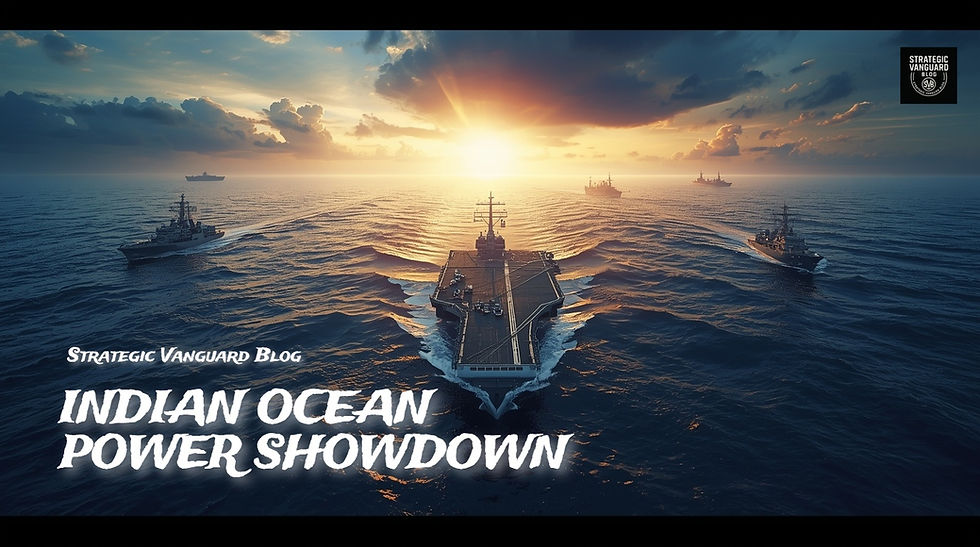The Influence of Geopolitical Turmoil on Global Shipping
- Manoj Ambat

- Mar 28
- 4 min read
Updated: Jul 9

Global shipping is the lifeblood of international trade, carrying an estimated 90% of all goods transported worldwide. This vast network of sea lanes supports a staggering $14 trillion worth of trade annually, connecting producers and consumers across continents. However, as the world’s geopolitical landscape becomes increasingly volatile, the maritime industry faces profound challenges that threaten to reshape its operations, costs, and efficiency.
The Foundation of Global Trade: Maritime Shipping
The global shipping industry operates through a series of critical sea lanes and chokepoints, including the Strait of Hormuz, the Suez Canal, and the Malacca Strait. These strategic routes facilitate the movement of goods ranging from crude oil and natural gas to consumer electronics and food supplies. With such an immense dependency on maritime trade, any disruption to these routes can ripple across global economies, affecting supply chains, trade balances, and even national security.
In monetary terms, the industry’s reliance on sea transport underscores its importance. Shipping lanes serve as arteries for a $14 trillion trade network, highlighting how dependent nations are on open and secure waterways. However, this dependency also makes the industry particularly vulnerable to geopolitical tensions and conflicts.
Geopolitical Events Reshaping the Maritime Landscape
Geopolitical events have always influenced shipping, but in recent years, these disruptions have become more frequent and impactful. Let’s explore some of the key factors contributing to these changes:
1. Trade Wars and Economic Sanctions
The U.S.-China trade war serves as a prime example of how economic disputes can disrupt shipping. Tariffs on goods force companies to rethink supply chains, redirect trade flows, and adapt to higher costs. Similarly, economic sanctions imposed on countries like Russia and Iran limit their access to global markets, forcing shipping companies to navigate complex legal and financial restrictions.
2. Conflicts and Territorial Disputes
Maritime disputes in the South China Sea—a region that handles about one-third of global trade—highlight the risks posed by unresolved territorial claims. With China’s aggressive militarization of the area, coupled with competing claims from neighboring nations, this region has become a flashpoint that threatens the free flow of trade.
3. Piracy and Terrorism
Despite advancements in maritime security, piracy and terrorism remain persistent threats. The Gulf of Guinea and the Strait of Malacca, for instance, see frequent attacks on vessels, endangering crew safety and cargo integrity. These security concerns often lead to higher insurance premiums and increased operational costs.
Economic Consequences of Geopolitical Turmoil
The impact of geopolitical turmoil on shipping is not confined to isolated incidents. Instead, it manifests in broader economic consequences that ripple through global markets. Some of the most notable effects include:
1. Rising Shipping Rates
When trade routes are disrupted, shipping rates tend to spike. For example, the closure of the Suez Canal in 2021 due to the Ever Given incident highlighted how a single chokepoint can halt global trade, leading to increased freight costs. Prolonged conflicts or territorial disputes can similarly inflate shipping rates, affecting businesses and consumers alike.
2. Supply Chain Disruptions
Geopolitical events force companies to reconsider their supply chain strategies. The COVID-19 pandemic and the Russia-Ukraine conflict have demonstrated how fragile global supply chains can be, with delays and shortages becoming commonplace. Diversifying supply chains to mitigate risks is an ongoing challenge for industries worldwide.
3. Economic Inequality Among Nations
Developing countries often bear the brunt of disruptions in maritime trade. With limited resources to adapt to rising shipping costs or supply chain delays, these nations face greater economic instability. In contrast, wealthier countries and companies can leverage their financial muscle to secure alternative trade routes or invest in new technologies.
Preparing for the Future: Strategies and Innovations
While the challenges are significant, the shipping industry is responding with innovative strategies and technological advancements. Here are some of the key trends shaping the future:
1. Diversification of Trade Routes
To reduce dependence on traditional chokepoints, countries are exploring alternative routes such as the Arctic Sea, the Belt and Road Initiative (BRI), and the International North-South Transport Corridor (INSTC). These new corridors offer opportunities to bypass geopolitical hotspots but come with their own set of challenges, including environmental concerns and high development costs.
2. Adoption of Green Shipping Technologies
With growing emphasis on sustainability, the shipping industry is investing in green technologies. From hydrogen-powered ships to energy-efficient port designs, these innovations aim to reduce carbon emissions while maintaining operational efficiency.
3. Integration of Digital Solutions
Technological advancements such as blockchain, AI, and big data are transforming the way the shipping industry operates. Real-time tracking, predictive analytics, and enhanced supply chain transparency are just a few of the benefits these tools offer, enabling companies to respond more effectively to geopolitical disruptions.
4. Strengthening International Collaboration
Collaboration among nations, international organizations, and the private sector is essential to address the challenges facing global shipping. Initiatives such as joint naval patrols, unified regulatory frameworks, and shared investment in port infrastructure can enhance security and resilience.
Conclusion: Navigating Uncharted Waters
The influence of geopolitical turmoil on global shipping is undeniable. From trade wars and territorial disputes to technological advancements and sustainable practices, the maritime industry is navigating a complex and ever-changing landscape. While challenges abound, so do opportunities for innovation and growth.
As we look to the future, it is clear that resilience and adaptability will be key to ensuring the continued flow of global trade. By investing in new technologies, diversifying trade routes, and fostering international collaboration, the shipping industry can weather the storms of geopolitical uncertainty and emerge stronger than ever.
What do you think will shape the future of global shipping? Share your thoughts in the comments below, and stay tuned for more insights into the forces shaping our world.



Comments